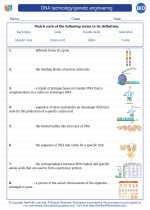CRISPR/Cas9
What is CRISPR/Cas9?
CRISPR/Cas9 is a revolutionary gene-editing technology that allows scientists to make precise changes to an organism's DNA. The CRISPR/Cas9 system is derived from a natural defense mechanism in bacteria that allows them to defend against viral infections.
Components of CRISPR/Cas9
The CRISPR/Cas9 system consists of two main components: the Cas9 protein and a guide RNA (gRNA). The Cas9 protein acts as molecular scissors that can cut the DNA at a specific location, and the gRNA guides the Cas9 protein to the desired location in the genome.
Applications of CRISPR/Cas9
CRISPR/Cas9 has a wide range of applications in biology and medicine, including gene therapy, creating genetically modified organisms, studying gene function, and potential treatment of genetic disorders.
How CRISPR/Cas9 Works
1. Design gRNA: The first step in using CRISPR/Cas9 is to design a gRNA that will guide the Cas9 protein to the target DNA sequence.
2. Delivery of CRISPR/Cas9: The CRISPR/Cas9 components are delivered into the target cells, where they will locate and bind to the specific DNA sequence.
3. DNA cleavage: Once the Cas9 protein is guided to the target DNA sequence by the gRNA, it will create a double-strand break in the DNA.
4. DNA repair: The cell's natural DNA repair machinery will then fix the double-strand break in one of two ways: non-homologous end joining (NHEJ) or homology-directed repair (HDR).
Ethical Considerations
As with any powerful technology, there are ethical considerations surrounding the use of CRISPR/Cas9, particularly in the context of germline editing and potential unintended consequences of gene editing.
Study Guide
Here are some key points to remember when studying CRISPR/Cas9:
.◂Biology Worksheets and Study Guides High School. DNA technology/genetic engineering

 Worksheet/Answer key
Worksheet/Answer key
 Worksheet/Answer key
Worksheet/Answer key
 Worksheet/Answer key
Worksheet/Answer key
 Vocabulary/Answer key
Vocabulary/Answer key
 Vocabulary/Answer key
Vocabulary/Answer key
 Vocabulary/Answer key
Vocabulary/Answer key
